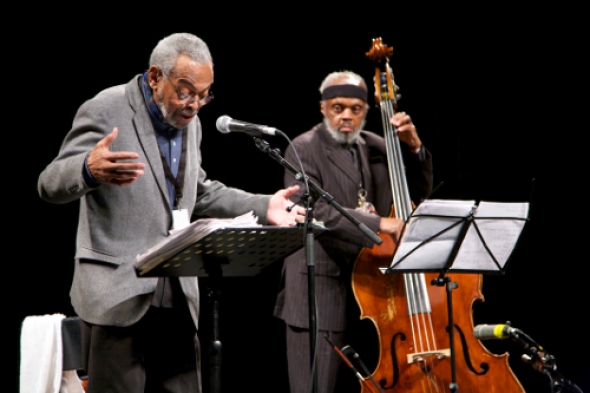Weaponise Aunt Hester’s Scream
In an expanded review of Arika 4: Freedom is a Constant Struggle, part of an ongoing series of mini-festivals, Sacha Kahir listens to the anguished language of noise and poetry inflected through black experience, politics and artistic traditions
weaponized feminity is about women who inflict damage with the terms of their femininity. women for whom the bounds of gender war exist within the oppressive space. (Sic) vicious maidens vicious in their maidenhood, vicious mothers vicious in their motherhood, vicious seductresses vicious in their seduction, women who make the tenets of their aggressive conspicuous femininity cruel.
– Nothing else moves that way1
The state form of life wants to take power away from you under the guise of education and inoculation. Immunising you against yourself, your femininity, your blackness, and your otherness. The only response is to turn the way you live, walk and talk into a weapon against its creeping enclosure.
We want Poems that kill,
assassin Poems, poems that shoot
guns. Poems that wrestle cops into alleys
and take their weapons leaving them dead
with tongues pulled out and sent to Ireland.
– Amiri Baraka2
Cut to darkened stage in Glasgow. There is a refrain which is repeated, chanted by different voices, versioned like a blues riff or a dub rhythm… ‘the tellingly inarticulate‘.3 Poetry works best when language breaks down, and when it breaks down further it becomes noise. Poetry and noise are a kind of democracy, or, more accurately, a dissensus, as Jacques Rancière would say. Because democracy is not consensus, we need not include the overprivileged and all their cops. Democracy does not begin in ancient Athens, but emanates from Aunt Hester’s scream, as witnessed by Fredrick Douglas. The beating of a black woman by her jealous slave master; jealous he couldn’t posses her will, and the enunciation of that event by her young nephew marked the beginning of a war by colonised peoples to civilise their colonisers.
On the stage a spotlight light illuminates the figure of Wadada Leo Smith, behind him is Glasgow, which the colonisers tell us was once the second city of empire, and is now a cultural hub. Glasgow, a former merchant city where many still suffer from Victorian diseases, and your postcode can predict your life expectancy. At points Wadada’s trumpet playing becomes a kind of wheezing, a gesture in which his instrument seems to merge with his body.
Freedom Now! Everything Now!
A politics of immanence, of life in the here and now, has gained ground since the falling away of grand narratives which had proposed obeying a schematics by which freedom and liberation lay only in some future setting; where the entrance fee was acceptance of suffering and toil in the present.
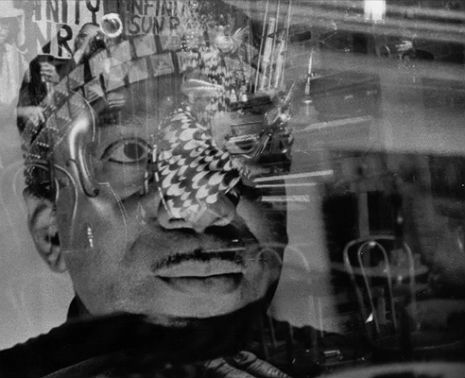
Image: Sun Ra in Edward O. Bland's film, The Cry of Jazz (1959)
Political immanence was always at the heart of the aesthetics that gave birth to jazz. As Edward O. Bland’s polemical film essay, The Cry of Jazz (1959), puts it: it had ‘bequeathed a futureless future’ through ‘the endless daily humiliation of American life’. The black wo/man responds by ‘glorifying the inherent joy and freedom in each present moment of life’, ‘through the improvised life thrust upon the negro.’ The same film had also, controversially, argued that Jazz was dead, and despite the snaking turns of innovations like be-bop, the form and the term both remained ‘too limiting’. The film draws to a close with Sun Ra trying to escape the endless repetitions of form and changes that underscore jazz, and the proclamation of a broader messianic role for the African diaspora in America – a messianic message first whispered into Nat Turner’s ear by a blackened sun. The film ends by alluding to an alternative messianic role for Black America – one that perhaps today Obama may embody? His likeness rendered by Shepard Fairey in the colours of the stars and strips can still be seen on T-shirts and posters. A second hue of blue adds another tonality suggesting a previously unseen layer to America, but is this layer blackness?
And yet it is not weakness, – it is the contradiction of double aims.
– W.E.B. Du Bois
Arika 4: Freedom is a Constant Struggle, was an event in Glasgow featuring a roll call of some of the most significant figures in black American poetry, free jazz and improvisation: Amiri Baraka, Wadada Leo Smith, Fred Moten, Sonia Sanchez, John Tilbury, Daniel Carter and William Parker. Operating alongside this tradition were previous Arika contributors Emma Hedditch, Mattin, Ray Brassier and Howard Slater.
Over the last couple of years Arika have ditched the traditional music festival set-up of their Instal series in favour of a more expanded format, encompassing critical pedagogy and group inquiry; collaborating with international sound art collective Ultra-red, as well as locally based collectives such as Glasgow Open School and Strickland Distribution.
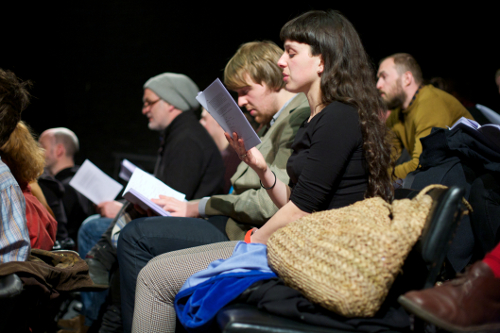
Image: Audience members collectively read M. NourbeSe Philip's epic poem, Zong!
Freedom is a Constant Struggle continued to explore Arika’s ongoing interest in the role that improvisation might have in relation to a politics of shared space and experience; foregrounding this theme in the experiences of the African diaspora. The event also explored notions of the self and its construction following a theme stretching back to previous episodes and bleeding into an upcoming episode.
The construct of negro, unlike the terms ‘African’, ‘Moor’, or ‘Ethiope’ suggested no situatedness in time, that is history, or space, that is ethno- or political geography.
– Cedric J. Robinson4
New Black Music is this: Find the self, then kill it.
– Amiri Baraka5
To what extent would you detourn yourself? When improvisation is successful, it puts everyone in a strange position: it makes us strangers.
– Mattin6
Find the self, then sell it is the logic behind the preformative mode of capitalism. A logic, which is increasingly prevalent as the boundaries between life and work, become progressively blurred. Every job application and interview recasts Alain Badiou’s notion of fidelity to the Event as fidelity to the advertised position. It demands a kind of fanaticism towards the available position. How will you actualise yourself within the company while simultaneously realising the company’s goals – to be answered in no more than 300 words? The truthful answer in four words ‘I need the money’ is insufficient, you must apply yourself to application; smear your ‘self’ within the box provided.
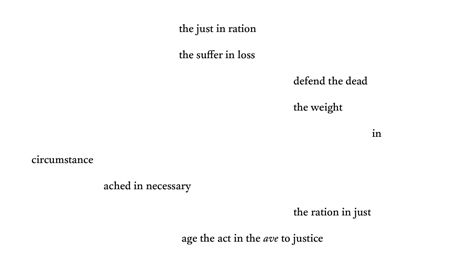
Image: page from M. NourbeSe Philip, Zong!, 2011
Escaping from a process of total reification, the transformation of human life into a commodity, would require a détournement of identity itself. As György Lukács formulated it: what is produced under capitalist relations appears in the guise of the natural order of things by which social relations are masked in a ‘phantom objectivity’. Equally, it can be said that a phantom identity or subjectivity is also formed. Freedom is sporadic, while subsumption to capital and its domination of the social terrain can be considered a constant. Just how free or unfree we are within our own personhood or selfhood is a spectre raised by philosopher Ray Brassier. The concept of a phantom subjectivity of selfhood or ‘mineness’ also appears in the work of neuro-ethical philosopher Thomas Metzinger who, in discussion with Brassier, appeared in a previous Arika episode: A Special Form of Darkness in February 2012.7 Metzinger states:
Taking the phenomenology of ownership seriously means to do justice to the fact that even in normal life the degree to which, for example, you prereflexively experience a certain property of your body or of your emotional personality as your own, or rather as something externally caused and not really belonging to your ‘true identity’, is highly variable. It changes, for instance, as you grow older. And, as philosophers and scientists alike know, the degree to which you actually experience a certain thought or argument as your own certainly depends on the response of your social environment.8
So how does the creation of selfhood relate to blackness or the performance of blackness, and is this essentially something that is always positioned against the responses of a social environment occupied by whiteness?
In discussion with Arika curator Barry Esson, writer, Fred Moten put forward a notion of blackness as reducible from black sociality by evoking certain ‘fugitive spaces’. From maroon communities of runaway slaves to places on the street like the hairdressers, Moten cites these places as evidence of an enduring black sociability. Black art emerges from fugitive spaces, as an aura forged by the horror of being stripped of everything including any right to thought or identity. The response is an immanent cosmogony, an erotic eschatology, transcribed in apocalypticalessianic terms on a biblical scale. Pure forms-of-life expressed in sorcery and witchcraft, a passing down of identity in secret, arranging an insurrection and an escape plan. If caught the punishment is cutting away a tendon in one of your feet, you can still work with a limp, or something even more severe.9
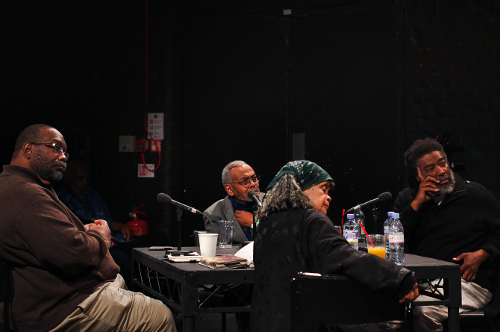
Image: 'The Experiment', (left to right) Fred Moten, Amiri Baraka, Sonia Sanchez and Wadada Leo Smith in conversation
‘Fugitive Spaces’ also suggests a street life evident in Jean Toomer’s poetics (Toomer is a figure invoked by Moten a number of times during the event), which railed against the uptight domesticity of literally ‘square’ whiteness
Rhobert wears a house, like a monstrous diver’s helmet, on his head […] he is sinking. His house a dead thing that weighs him down.10
As Nathaniel Mackey notes, in Toomer’s poetics ‘houses epitomize a reign of hard sharp edges, rectilinear pattern, fixity, regimentation, a staid, white order’ for the black southern migrant forced into an ‘uptight domesticity’.11 This ‘uptight domesticity’ continues to underpin the social reproduction of our post-Fordist landscape where desire often still battles within four walls. Toomer proclaims a weaponised seduction within blackness where
Houses are shy girls whose eyes shine reticently upon the dusky body of the street […] stir the root life of a withered people. Call them from their houses, and teach them to dream. Dark swaying forms of Negros are street songs that woo virginal houses.12
The ‘uptight domesticity’ of the Thatcher years meant that as a child, for myself and many others, the house was often a kind of prison. Life existed elsewhere: out in the streets, in fugitive spaces, like the brown field sites where nature had reclaimed land from industry, and where we could play at becoming young savages in the superfluity of not yet properly formed identities. A jumping, running, spitting, screaming, fire-raising cavalcade that would abruptly come to a halt with a grazed knee or the invoking of a name that signposted the fact that you were you and not everyone and everything else. We would also look to America for a hallucinatory sense of identity; it was Black America in particular that set the imagination alight from within the televisonary empire transmitted into our homes.
It can be said that Obama helped, at least temporarily, to save America’s global image after the G.W. Bush years. Black America representing an aspect of American culture that is greatly admired around the world. As Amiri Baraka has stated, it also helped ‘cool out’ African American dissent. It seems fitting to come back again to Edward O. Bland's film essay, The Cry of Jazz, whose ending suggests Black Americans’ potential role as both destroyers but also saviours of America, through a ‘vindication of America’s posture’, as transcribed onto a statue of liberty that proclaims: ‘Give me your tired, your poor, your huddled masses yearning to breathe free; the wretched refuse of your teeming shore’. With regards to ‘another’ America the question should be posed: what if socialism in one country had occurred in America rather than Russia? Would the multitude of nationalities that populate her have given it an innate internationalism?
MOTHERFUCKER, the expression itself suggests a kind of plane of radical immanence – everything now in an endless self-procreating loop – a total embeddedness. Sonia Sanchez, poet, grandmother, activist; key figure in the Black Art’s Movement of the ’60s and ’70s, adds the refrain Motherfucker to signify in the punchline that a character in a joke is black.
The joke is a precursor to a discussion, punctuated and made sensible by an occasional tear and stutter, featuring Amiri Baraka, Fred Moten, Sonia Sanchez, and Wadada Leo Smith. The discussion explored the theme of blackness within America. Discussing the advances into institutions, including the incursion into the university of Black studies.
The question of Obama is raised in terms of what it has meant for legitimating the United States globally. All of the participants acknowledge America’s role as a military empire during the debate, but there is disagreement on the role of representational democracy. It is easy to forget the complexity of Black peoples’ struggles in America and the various tactics that were called for. From Rosa Park’s act of refusal, battles for the right to suffrage, and against segregation, to armed militancy, breakfast programmes and equally the creation of Black studies as a recognised subject valid for institutional inquiry. It is easy to forget the difficulties of establishing Black Studies; Sonia Sanchez illuminates this with an anecdote involving FBI agents appearing at her door enquiring about the subversive implications of the subject.
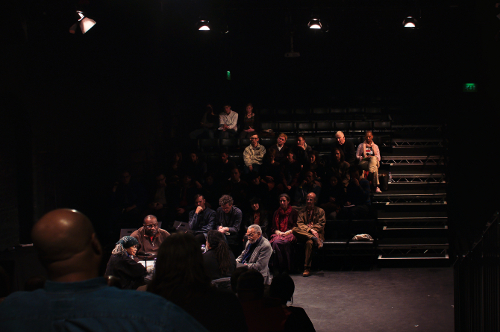
Image: 'The Experiment', (left to right) Sonia Sanchez, Fred Moten, Wadada Leo Smith and Amiri Baraka in conversation
A Deriddian neologism ‘invagination’, which Fred Moten uses in his book In the Break, may be useful in unfolding these strategic tensions.13 Invagination denies both inside and outside a stable identity. This can be applied to the complex strategies that African American’s have had to adopt, seeking on the one hand recognition (of even having a voice) after being depicted as people with no recognisable place or culture, while on the other hand, having to act against the very system that oppressed them. Moten’s forthcoming book, The Undercommons: Fugitive Planning & Black Study, co-authored with Stefano Harney, expands on these themes of operating inside, outside, against and underneath the university system. Whilst at the same time Moten and Harney warn,
Governance is the annunciation of universal ex-change. The exchange through communication of all institutional forms […] the hospital talks to the prison which talks to the university which talks to the NGO which talks to the corporation through governance, and not just to each other but about each other.14
Here again strategies of the inarticulate play a subversive role, when communication itself is put to the task of surveillance and a kind of colonialism from below, the strategy of hiding messages within a noise that is unrecognisable to state thought takes on a protective function.
Din is discourse […] Since speech was forbidden, slaves camouflaged the word under the provocative intensity of the scream. It was to be nothing but the call of the wild animal. This is how the dispossessed man organized his speech by weaving it into the apparently meaningless texture of extreme noise.15
Sociology and other human sciences often risk working on behalf of the state. For example the ‘Reading the Riots’ study, conducted by The Guardian and The London School of Economics in the aftermath of the 2011 London Riots, could be said to actually contribute knowledge towards better controlling the subjects of their study by abetting various state institutions, under the guise of understanding. Sociology from below should act like a brick through a window, in the manner developed by Romano Alquati’s studies and propagation of sabotage within the Italian workplace of the 1970’s.
This is a theatre of assault. The play that will split the heavens for us will be called THE DESTRUCTION OF AMERICA.16
The last day of Freedom is Constant Struggle featured performances by both Sonia Sanchez and Baraka. Each can be said to weaponise their performances. By this I do not mean by creating weapons in the manner of the state – weapons of mass destruction that indiscriminately murder and call it ‘collateral damage’ – but words, and gestures and ticks of the nervous system that are honed for a precise form of semiotic attack. Sanchez’s stutter and tears lend a kind of directness to her performance, realizing Antonin Artaud’s theater of cruelty adding ‘a physicality into language and poetry: a sense of body equated with, inseparable from, the mind that suffers it.’17
Baraka recites his notorious response to 9/11 ‘Somebody Blew Up America?’ underscored by Henry Grimes’ walking double Bass. Bringing the weekend’s proceedings to a close, asking: ‘Who genocided Indians, tried to waste the black nation? Who lives on Wall Street the first plantation?’; and later: ‘Who killed Rosa Luxemburg?’; and: ‘Who want the world like it is?’ It is of course the same enemy from whom, if victorious, ‘not even the dead will be safe', as Walter Benjamin declared.18 So the question which follows is: how do you weaponise an audience who, including myself, seem to be too well trained? The left, when operating within two regimes – of either a state form of thought, or a weak horizontalist orthodoxy – seems too well suited to the task of management.
Sacha Kahir <cthulhu_studies AT yahoo.co.uk>has been engaged in a human strike since leaving school in the late ‘80s. He occasionally scabs off to do some work, which can be seen here http://www.sachakahir.co.uk/
Info
Arika 4: Freedom is a Constant Struggle took place at the Tramway, Glasgow 18–21 April 2013. The next episode Arika 5: Hidden in Plain Sight is held 24–26 May 2013 Tramway, Glasgow, and explores: what is the link between the exuberance, flamboyance, artifice and (ironic) embellishment of queer, gay, lesbian, trans or bi artforms – voguing, drag and lypsync, deep house – and the communities, politics and specificities that produced them – a politics of race, class and gender, of public health, of mourning and militancy, affect, emotion and melancholy? With queer theorists, performance artists, archivists, theologians, visual artists and filmmakers including: Vjuan Allure, Antonia Baehr, Cecilia Bengolea, boychild, Pauline Boudry, François Chaignaud, Ann Cvetkovich, DJ Sprinkles, Marlene Monteiro Freitas, Jack Halberstam, Trajal Harrell, Emma Hedditch, Renate Lorenz, Jimmy Robert.
Footnotes
1 Nothing else moves that way, ‘WTF is weaponized femininity anyway’, http://hotelsongs.tumblr.com/post/45146160340/wtf-is-weaponized-femininity-anyway
2 Amiri Baraka, ‘Black Art’ in Michael S. Harper and Anthony Walton (Eds.), Vintage Book of African American Poetry, New York: Vintage, 2000.
3 Howard Slater, ‘Listener as Operator’, http://www.metamute.org/editorial/mute-music/listener-operator see also Nathaniel Mackey, Discrepant Engagement: Dissonance, Cross – Culturality, and Experimental Writing, Cambridge: Cambridge University Press, 1993, p.235.
4 Cedric J. Robinson, Black Marxism: The Making of the Black Radical Tradition, Chapel Hill and London: University of North Carolina Press, 2000, p.81.
5 Amiri Baraka, Black Music, AkashiClassics: Renegade Reprint Series, 2000.
6 Mattin, Unconstituted Praxis, Anthony Iles (Ed.) published as part of Noise and Capitalism, CAC Bretigny, 2010, available as a download at http://www.cacbretigny.com/unconstituted_praxis.pdf
7 See: http://arika.org.uk/events/episode-2-special-form-darkness reviewed by Eugene Thacker for Mute, ‘The Mourning of Anti-Music’, http://www.metamute.org/editorial/occultural-studies-column/mourning-anti-music-0
8 Thomas Metzinger, Being No One: The Self-Model Theory of Subjectivity, Cambridge Mass.: MIT Press, 2003. See also http://phantomself.org/a-special-form-of-darkness-metzinger-on-subjectivity/
9 Cedric J. Robinson, ibid., pp.139-139
10 Jean Toomer, ‘Rhobert’, Cane, New York: Liveright Paperbacks, 2011, p.55.
11 Nathaniel Mackey, Discrepant Engagement: Dissonance, Cross–Culturality, and Experimental Writing, Cambridge: Cambridge University Press, 1993, p.238.
12 Jean Toomer, ‘Box Seat’, Ibid., p.76.
13 Fred Moten, In The Break: The Aesthesis of the Black Radical Tradition, University of Minnesota Press, 2003, p8
14 Stefano Harney and Fred Moten, The Undercommons: Fugitive Planning and Black Studies, New York: Minor Compositions, 2013, p.57.
15 Edouard Glissant, Caribbean Discourses and Other Essays, cited in In the Break, op.cit., p.7.
16 Amiri Baraka & Leroi Jones, ‘The Revolutionary Theater’, Liberator, June 1965, http://nationalhumanitiescenter.org/pds/maai3/protest/text12/barakatheatre.pdf
17 Commentary by Jerome Rothenberg and Pierre Jorris on Antonin Artaud, Rothenberg and Jorris (Eds.), Poems for the Millenium: The University of California Book of Modern and Postmodern Poetry, Berkely: The University of California, 1997, p.521.
18 Walter Benjamin, ‘Theses on the Philosophy of History’, Illuminations, Pimlimco, 1999, p.247.
Mute Books Orders
For Mute Books distribution contact Anagram Books
contact@anagrambooks.com
For online purchases visit anagrambooks.com

